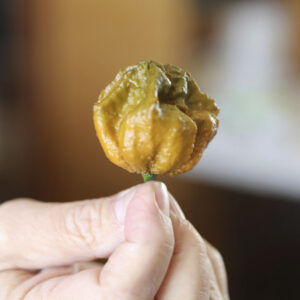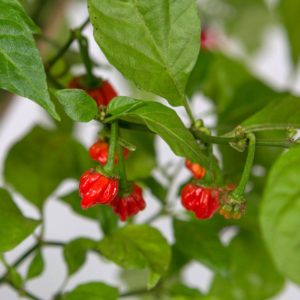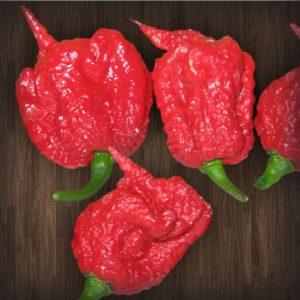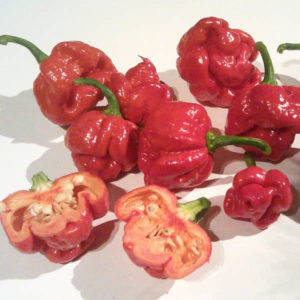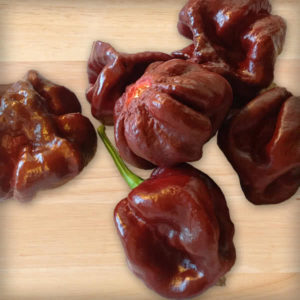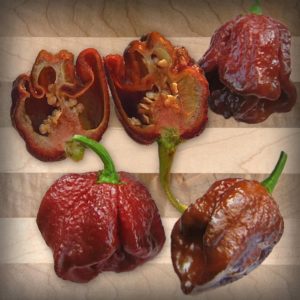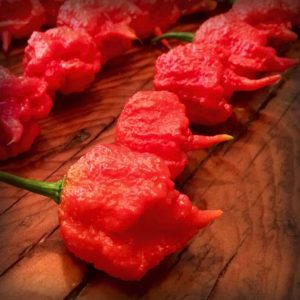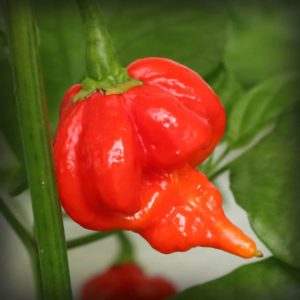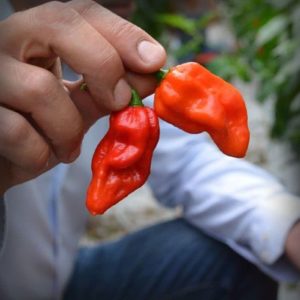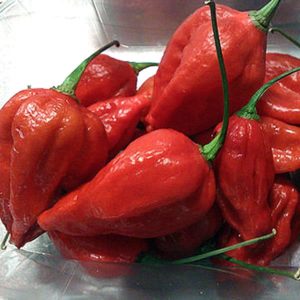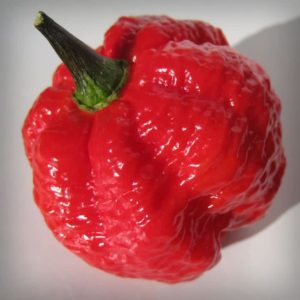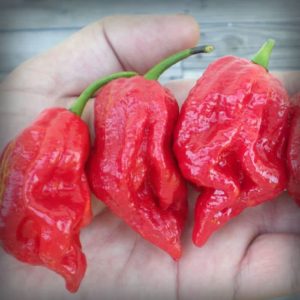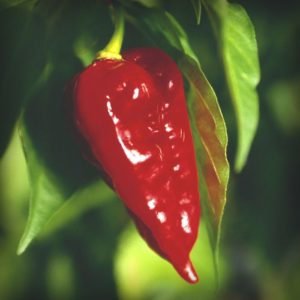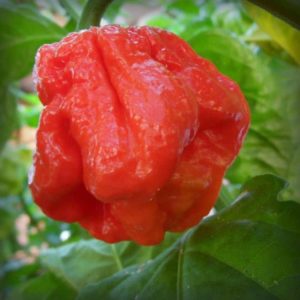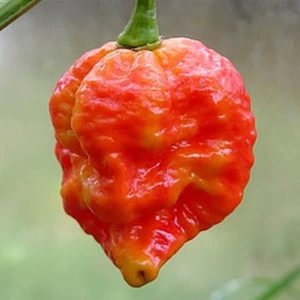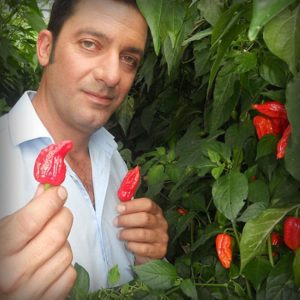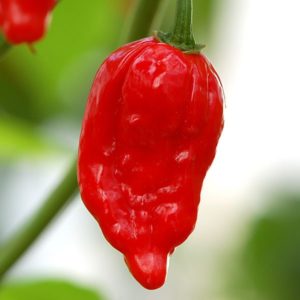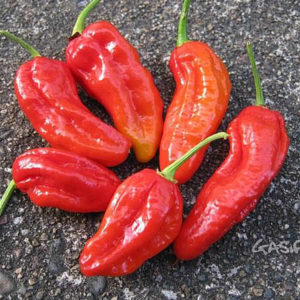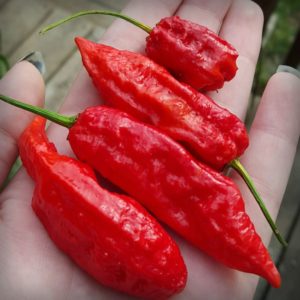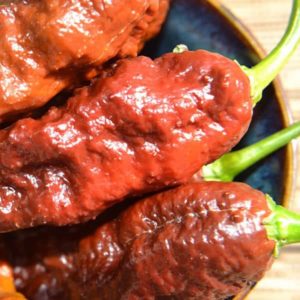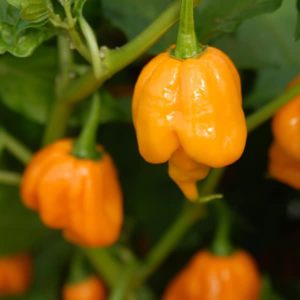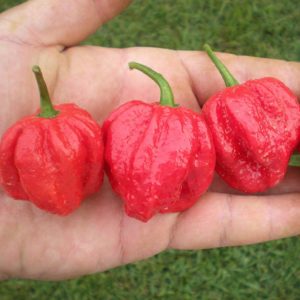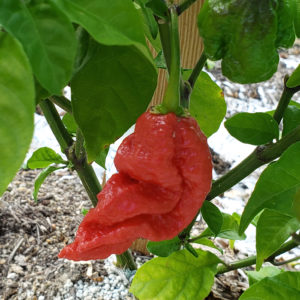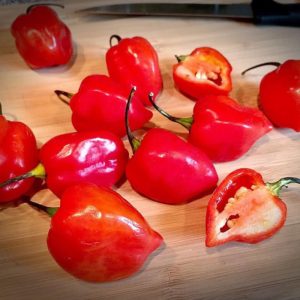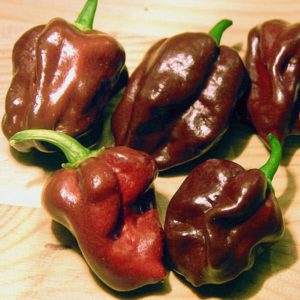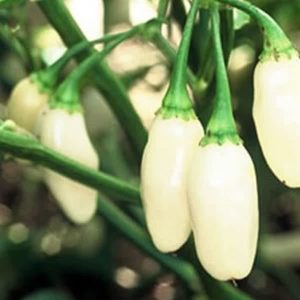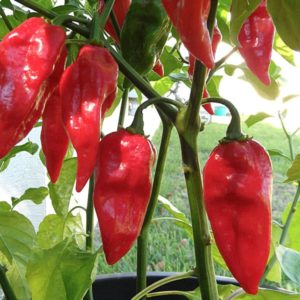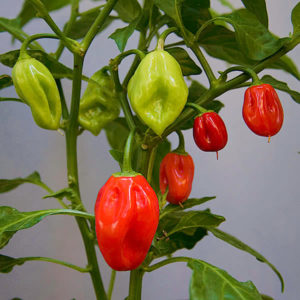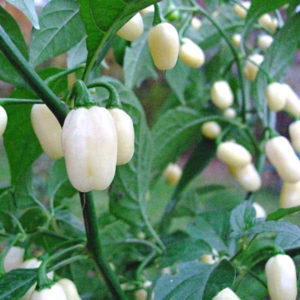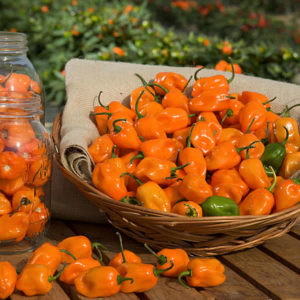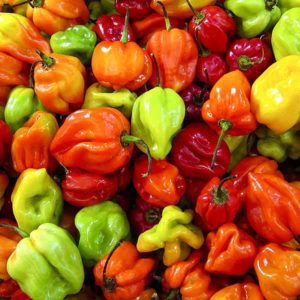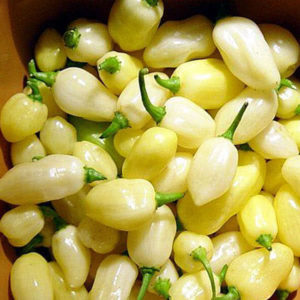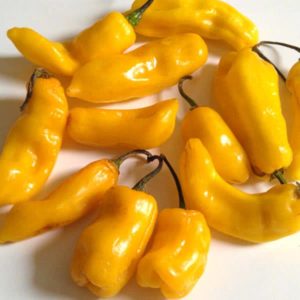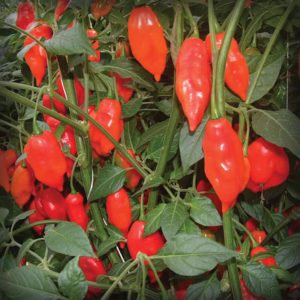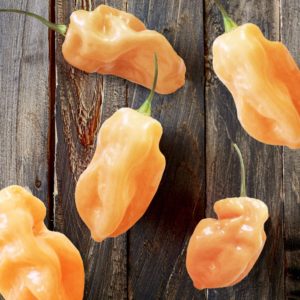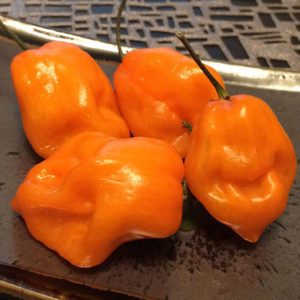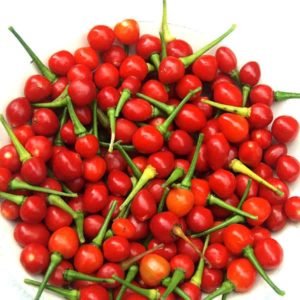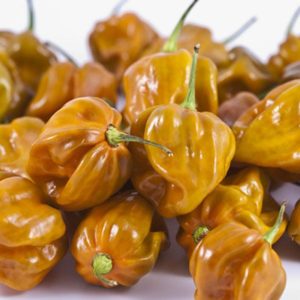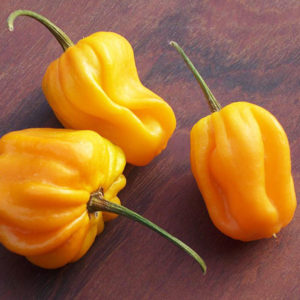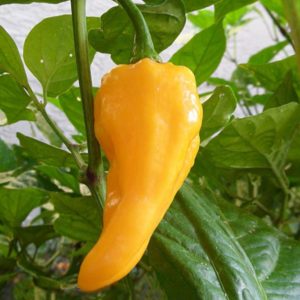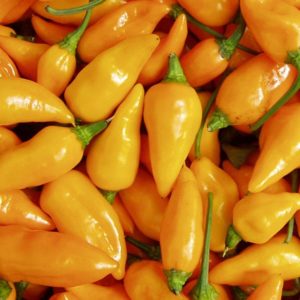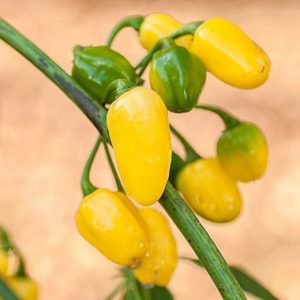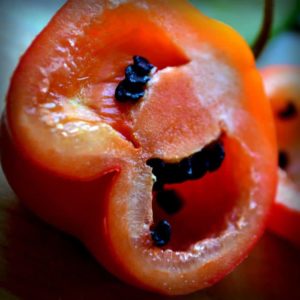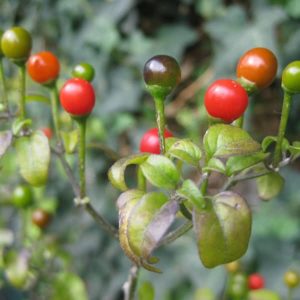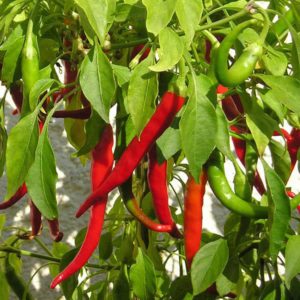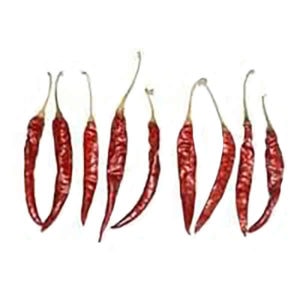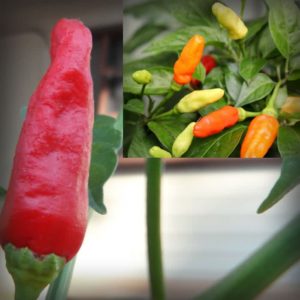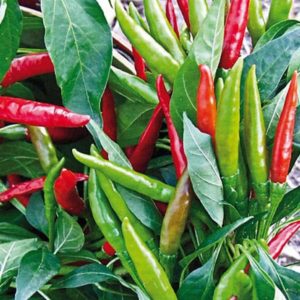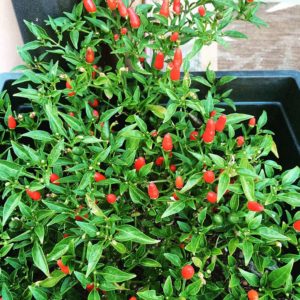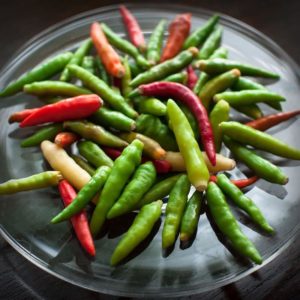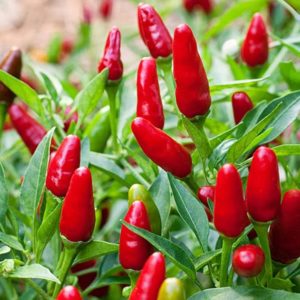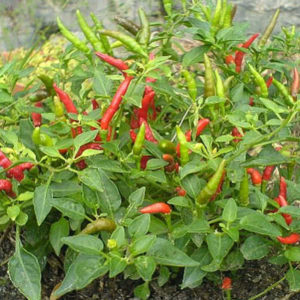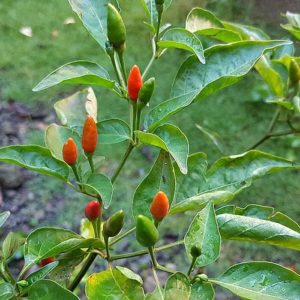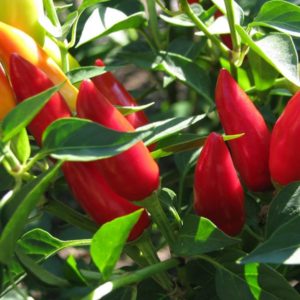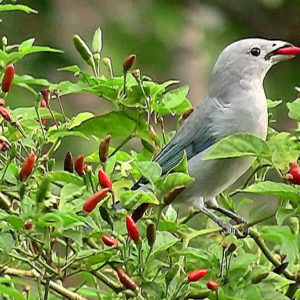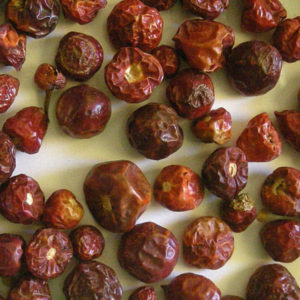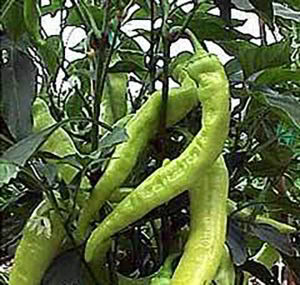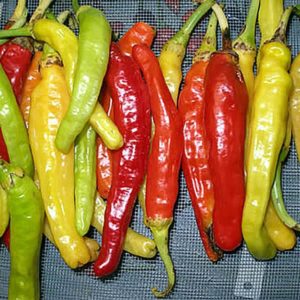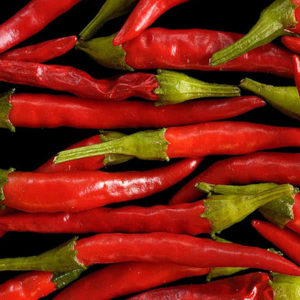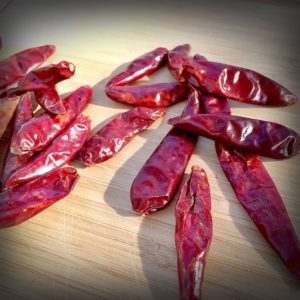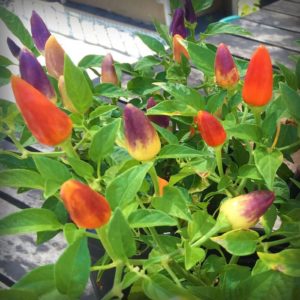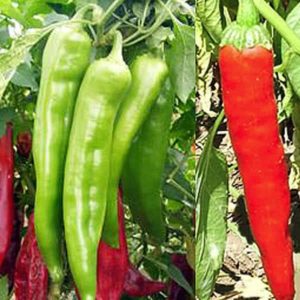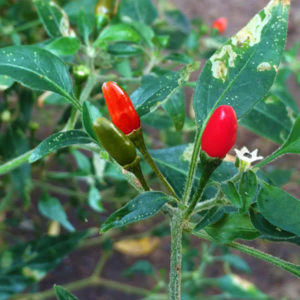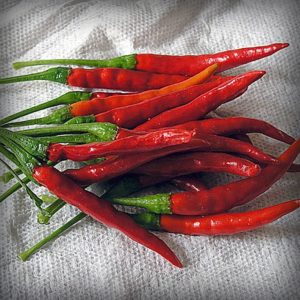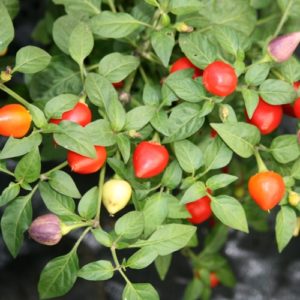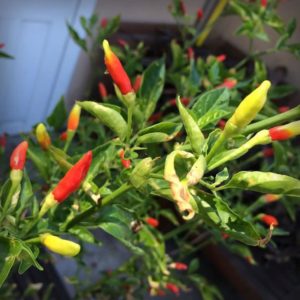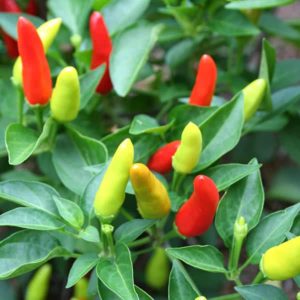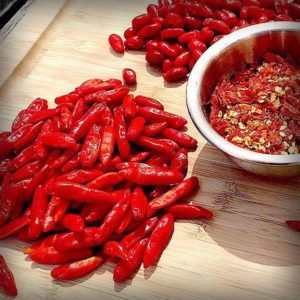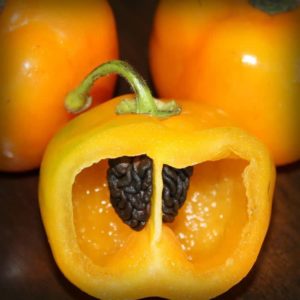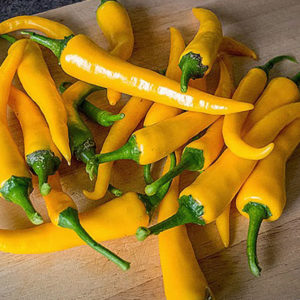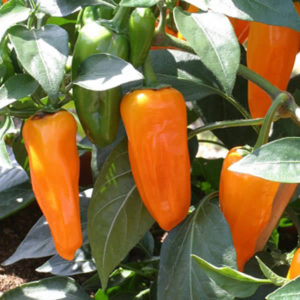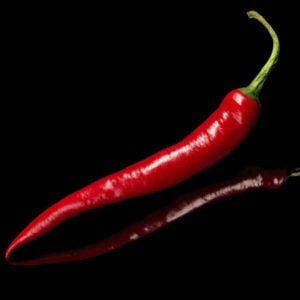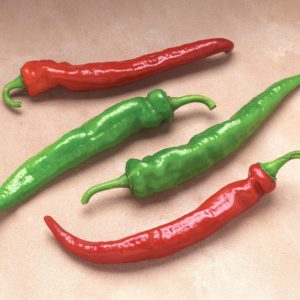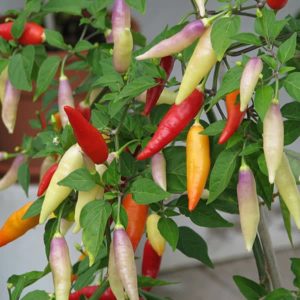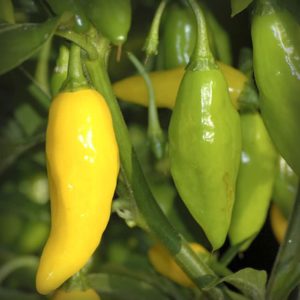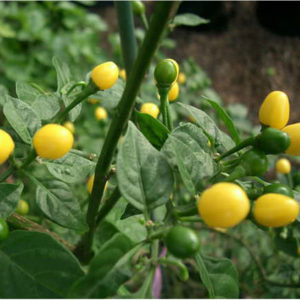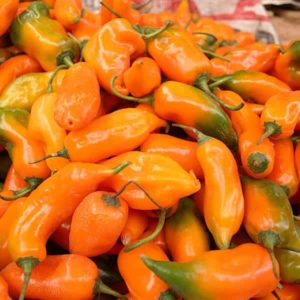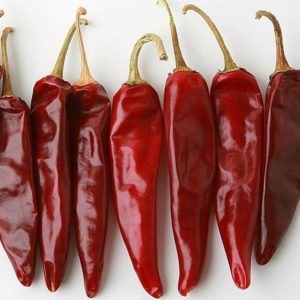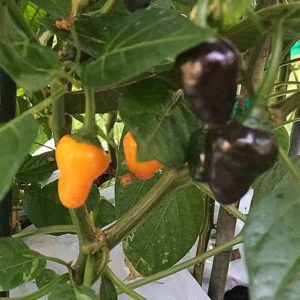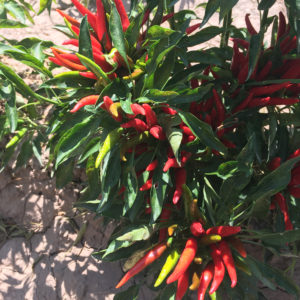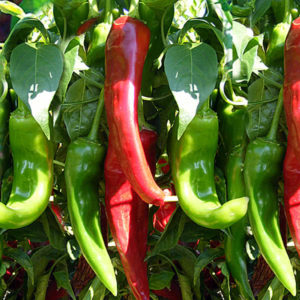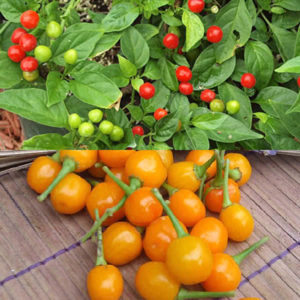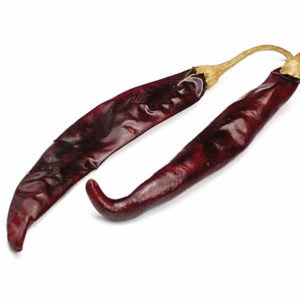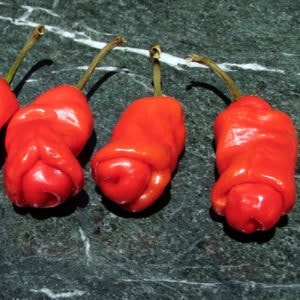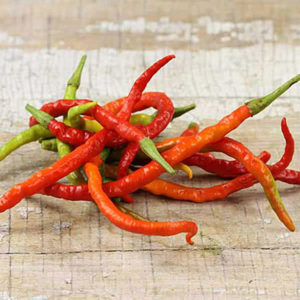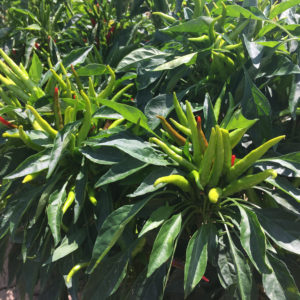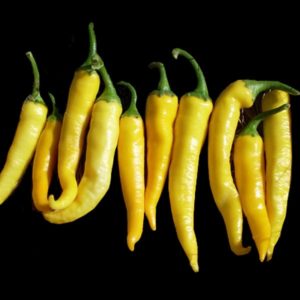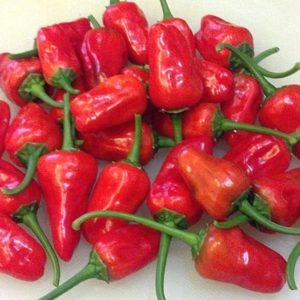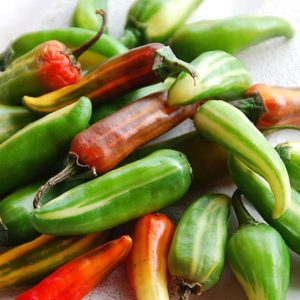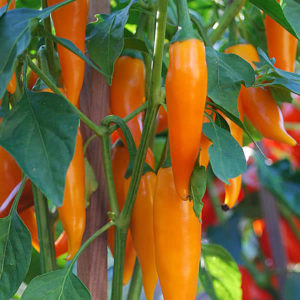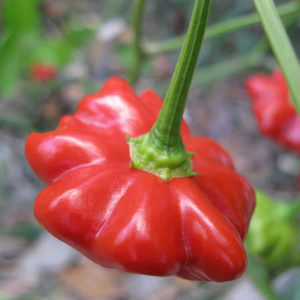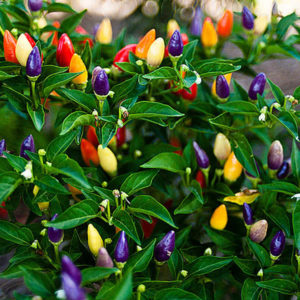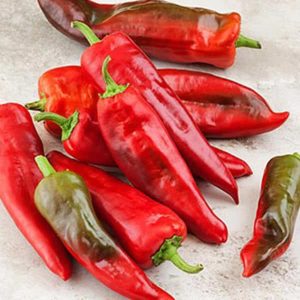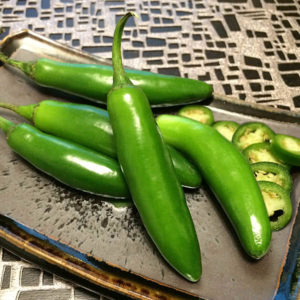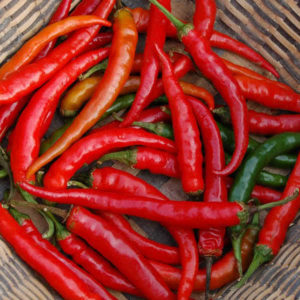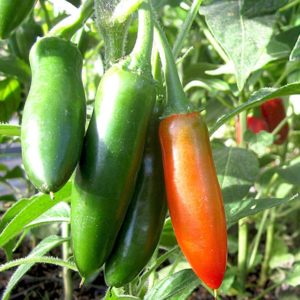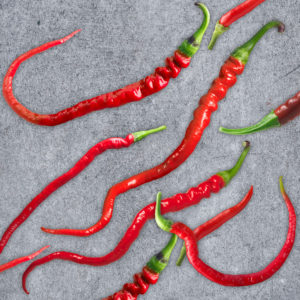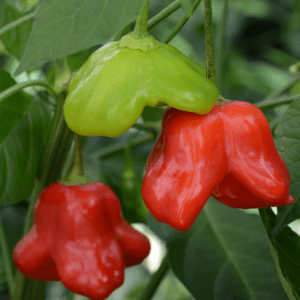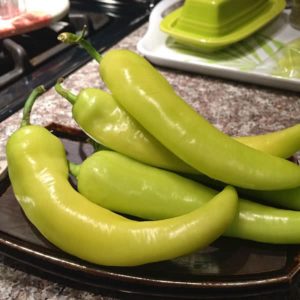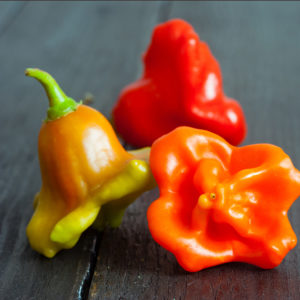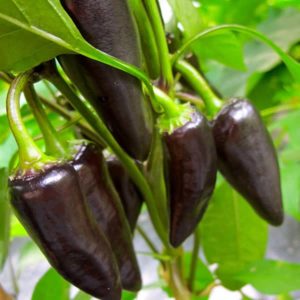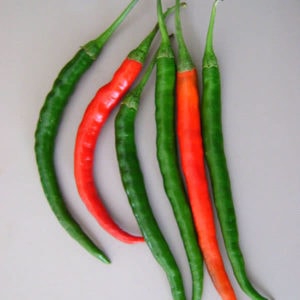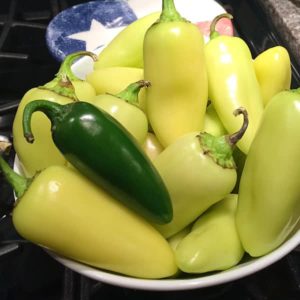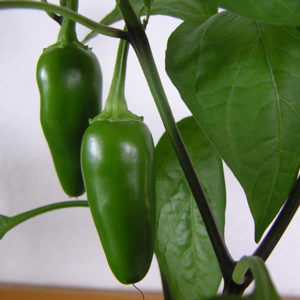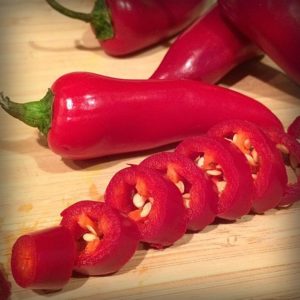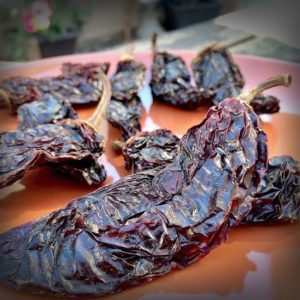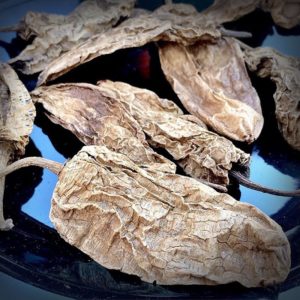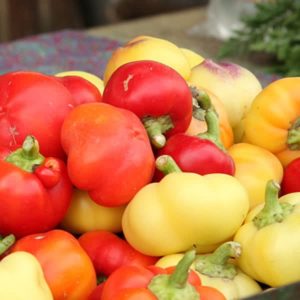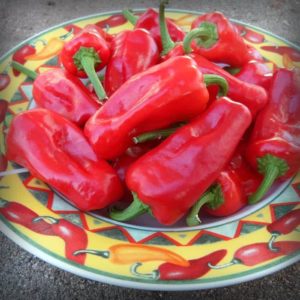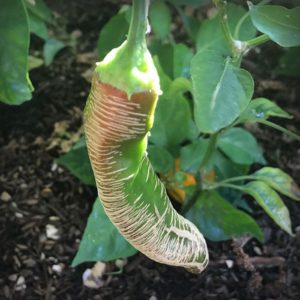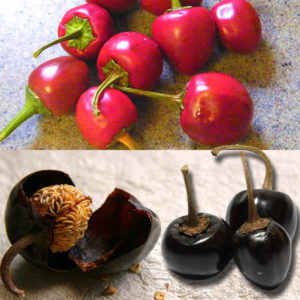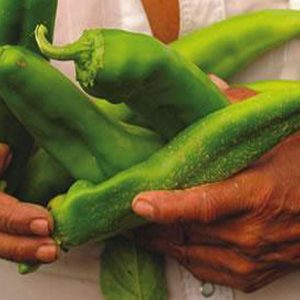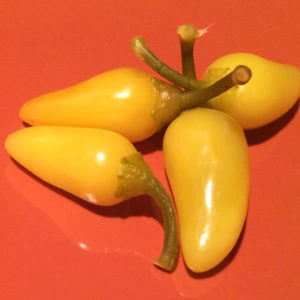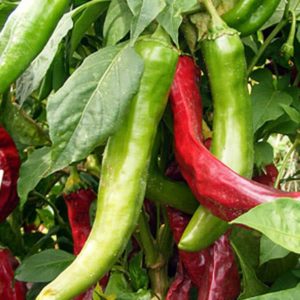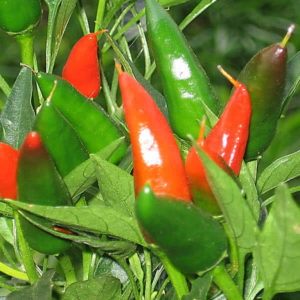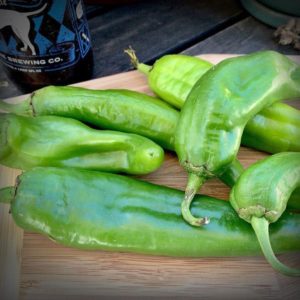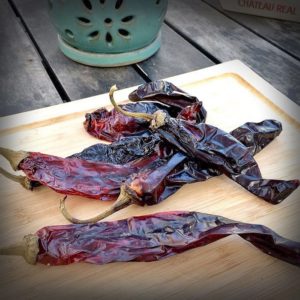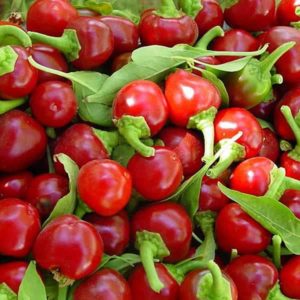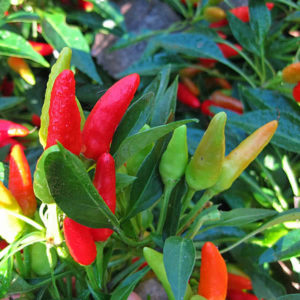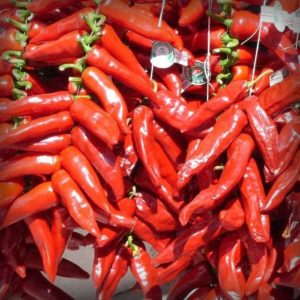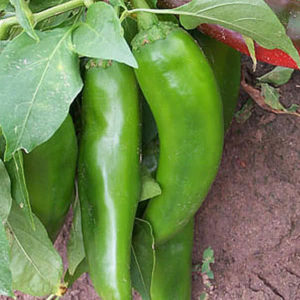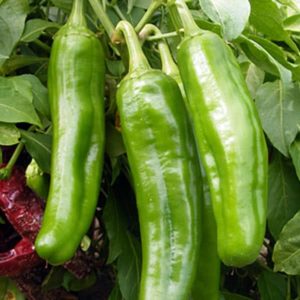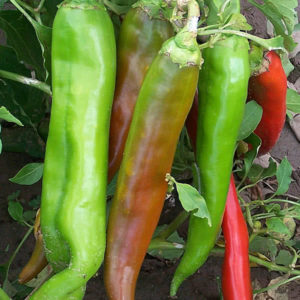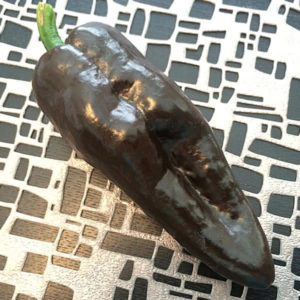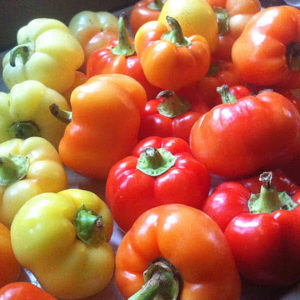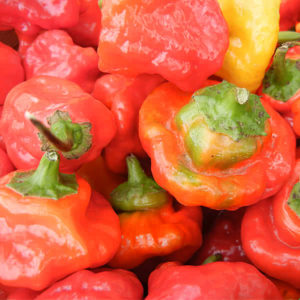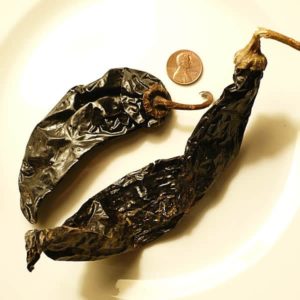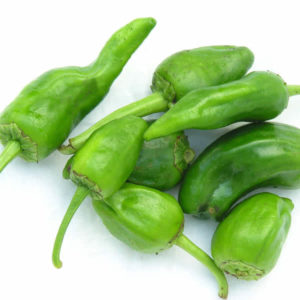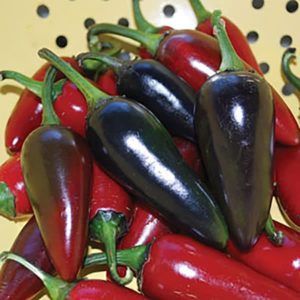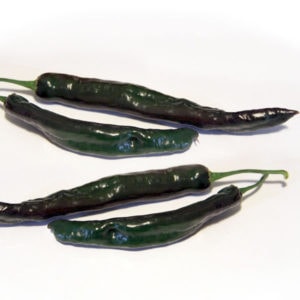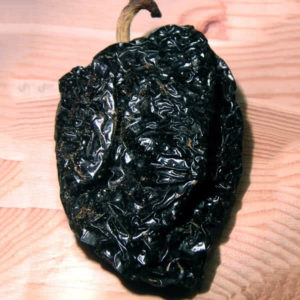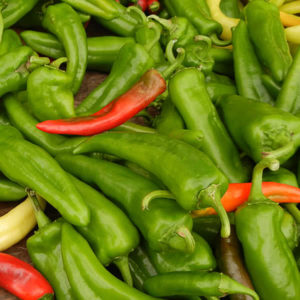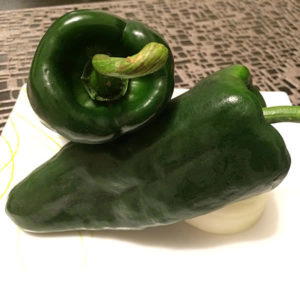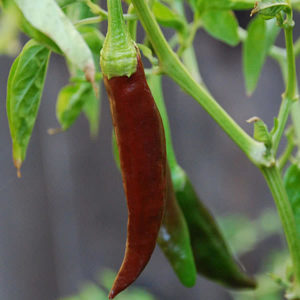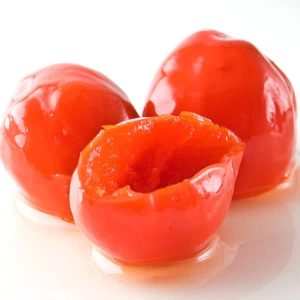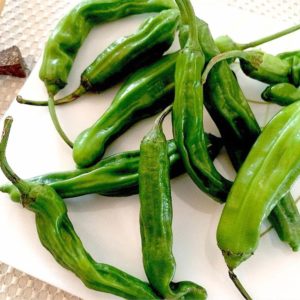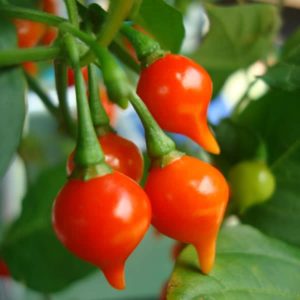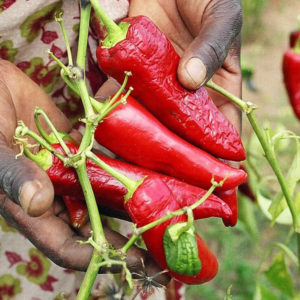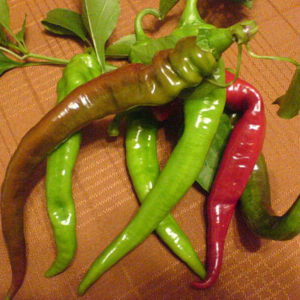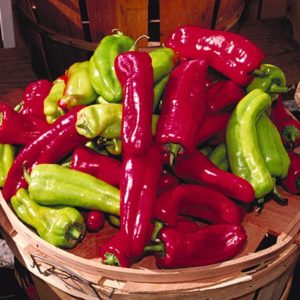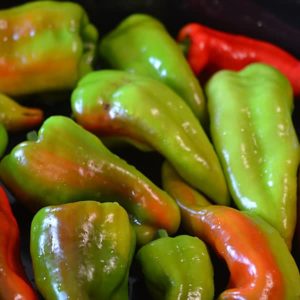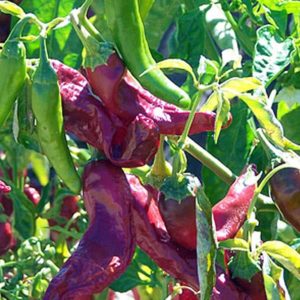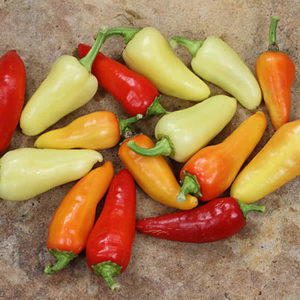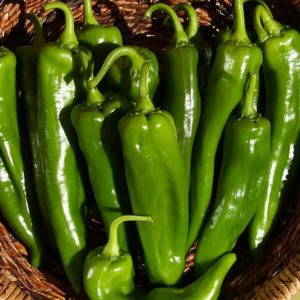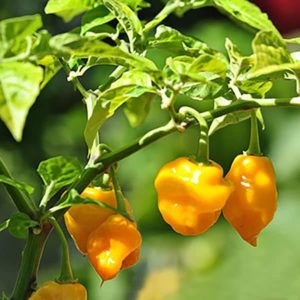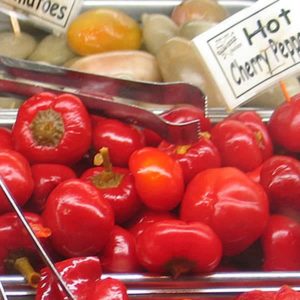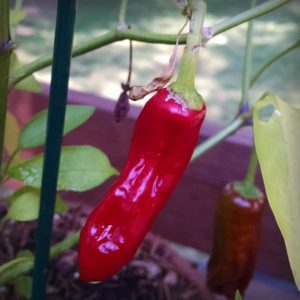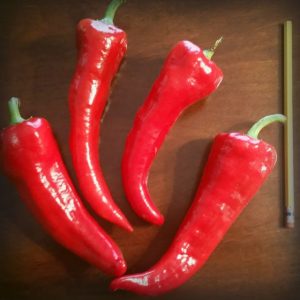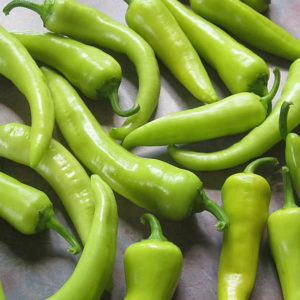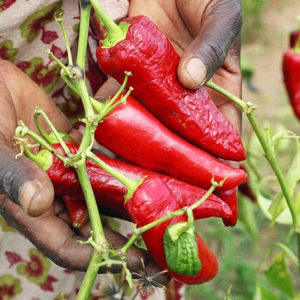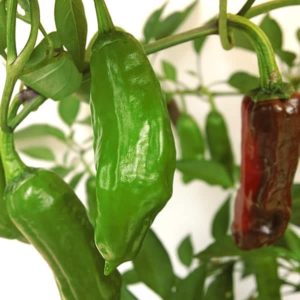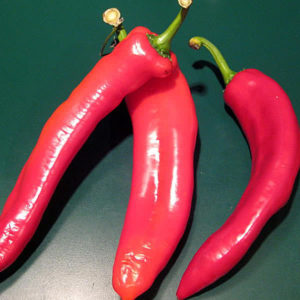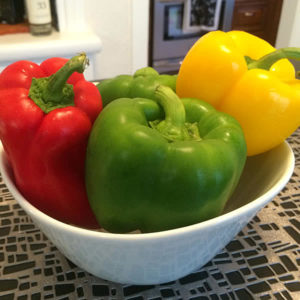- Below you will find all peppers sorted by heat in Scovilles
- The Big List of Hot Peppers includes Scoville rating, detailed description, and photos of each pepper.
- Click on each pepper for even more info.
- Search for countries, types, and key terms by typing into the Search field.
- Searches are combined. See all peppers again by hitting the Reset button.
- Results will be updated automatically.
Pepper X
Capsicum ChinenseIt’s finally official! As of August 2023, Guinness World Records recognized Pepper X as the world’s hottest pepper, rating at an average of 2,693,000 Scoville Heat Units (SHU). Pepper X’s sizzling Scoville score was calculated by Winthrop University in South Carolina, which conducted tests using specimens from the past four years.
- Scovilles: 2693000
- Origin: USA
Dragon’s Breath
Capsicum chinense2,480,000 Scoville Units? Well it’s never been tested. There has never been any official testing of this pepper. When Guinness (or any official testing facility) does testing that confirms the actual Scoville rating for this pepper, I will make it official here. Until then, it’s all hearsay.
- Scovilles: 2480000
- Origin: Wales
Carolina Reaper
Capsicum Chinense1,569,383 – 2,200,000 Scoville Units. Smokin’ Ed’s Carolina Reaper held the official title as the world’s hottest pepper for a decade, August 2013 – 2023. Now Ed Currie has a new pepper at the top, Pepper X.
- Scovilles: 2200000
- Origin: USA
Trinidad Moruga Scorpion
Capsicum Chinense1,200,000 – 2,000,000 Scoville Units. The New Mexico State University’s Chili Pepper Institute identified the Trinidad Moruga Scorpion as the newest hottest chili pepper in the world as of February 2012.
- Scovilles: 2000000
- Origin: Trinidad
7 Pot Brown (Chocolate 7 Pot)
Capsicum Chinense800,000 – 1,853,396 Scoville Units. This pepper is a relatively new variation on the original Trinidad 7 Pot superhots. Ripe pods are brown in color, with the internal membrane covering much of the inside of the pepper is white. There is still some debate as to whether the brown or chocolate 7 Pot is the same variety as the Douglah (above).
- Scovilles: 1853396
- Origin: Trinidad
7 Pot – Pod Douglah (Trinidad Douglah)
Capsicum Chinense923,000 – 1,853,396 Scoville Units. From Trinidad, it’s said that 1 pod will spice seven pots of stew. It is a rare and extremely hot chili. The Douglah is characterized by a dark brown/deep purple skin.
- Scovilles: 1853396
- Origin: Trinidad
7 Pot Primo
Capsicum Chinense1,473,480 Scoville Units. Created by Troy Primeaux, a horticulturist from Louisiana. He began crossing the Naga Morich and Trinidad 7 Pot seeds around 2005. The 7 Pot Primo can get very lumpy and distorted and even grow a skinny little tail.
- Scovilles: 1473480
- Origin: USA
Trinidad Scorpion “Butch T” Pepper
Capsicum Chinense1,463,700 Scoville Units. Propagated by Butch Taylor of Zydeco Hot Sauce and grown by the Chilli Factory, the Trinidad Scorpion ‘Butch T’ variety pepper was formerly ranked as the hottest pepper in the world.
- Scovilles: 1463700
- Origin: Trinidad
Komodo Dragon
Capsicum Chinense1,400,000 Scoville Units. The latest variation on the 7 pod, naga, jolokia, etc is the Komodo Dragon. Grown by the UK’s largest producer of chillies, Salvatore Genovese.
- Scovilles: 1400000
- Origin: UK
Naga Viper
Capsicum Chinense1,382,118 Scoville Units. The Naga Viper was created in England by chilli farmer Gerald Fowler. It was briefly the “World’s Hottest Chilli” in 2011 according to the Guinness World Records.
- Scovilles: 1382118
- Origin: UK
7 Pot Brain Strain
Capsicum Chinense1,000,000 – 1,350,000 Scoville Units. The 7 Pot Brain Strain was developed using selective breeding by saving pods from plants that would produce a lumpy, grainy texture like the human brain. A very productive chile plant, many growers say this is the hottest of the red 7 Pot strain chile plants.
- Scovilles: 1350000
- Origin: Trinidad
7 Pot Barrackpore
Capsicum Chinense1,000,000 – 1,300,000 Scoville Units. This 7 Pot variety comes from the region of Barrackpore on the Caribbean Island of Trinidad. The Trinidad 7 Pot Barrackpore has an elongated pod structure sometimes similar to the Bhut Jolokia.
- Scovilles: 1300000
- Origin: Trinidad
Dorset Naga
Capsicum Chinense544,000–1,221,000 Scoville Units. The scorching heat of the fruit is combined with a distinctive fruity aroma, making this a truly exceptional chile. Fruits ripen from green to red, and may be harvested at either stage of maturity. Typically about 1” x 2” in size (30 x 50mm).
- Scovilles: 1221000
- Origin: UK
7 Pot Jonah
Capsicum Chinense800,000 – 1,200,000 Scoville Units. The 7 Pot Jonah is a larger plant that produces larger and rounder Trinidad 7 Pot strain pods, with a fruitier flavor than the standard 7 Pot and slightly higher heat.
- Scovilles: 1200000
- Origin: Trinidad
7 Pot Infinity
Capsicum Chinense1,176,182 Scoville Units. The Infinity Chilli pepper held the World Record for the world’s hottest chili pepper for two weeks in 2011, before it was ousted by the Naga Viper chili.
- Scovilles: 1176182
- Origin: UK
Bedfordshire Super Naga
Capsicum Chinense900,000 – 1,120,000 Scoville Units. Unleashed by Salvatore Genovese in 2012, the Bedfordshire Super Naga was the UK’s hottest commercially grown chilli pepper at that time.
- Scovilles: 1120000
- Origin: UK
Naga Morich
Capsicum Chinense1,000,000 – 1,100,000 Scoville Units. A chili pepper native to North East India and the Sylhet region of Bangladesh. The Naga Morich is extremely hot, but has a flavor that is quite unique.
- Scovilles: 1100000
- Origin: Bangladesh
Spanish Naga (Gibralta Naga) Pepper
Capsicum Chinense1,086,844 Scoville Units. The Gibralta Naga, or Spanish Naga, is grown in Spain, but was developed in the UK from Naga Peppers from India.
- Scovilles: 1086844
- Origin: UK
Ghost Pepper (Bhut Jolokia)
Capsicum Chinense800,000 – 1,041,427 Scoville Units. Also known as naga jolokia, naga morich, bih jolokia, u-morok, ghost pepper, and red naga chilli. In 2007 The Ghost Pepper was certified as the hottest Chili Pepper on the planet in The Guinness Book of World Records, but no longer holds that title.
- Scovilles: 1041427
- Origin: India
Bhut Jolokia Chocolate
Capsicum Chinense800,000 – 1,001,304 Scoville Units. The Bhut Jolokia Chocolate is a rare, natural variant of the Bhut Jolokia Red. It has all the characteristics of the Bhut Jolokia Red, but is much sweeter and delicious, but still deadly hot.
- Scovilles: 1001304
- Origin: India
Trinidad Scorpion CARDI
Capsicum Chinense800,000 – 1,000,000 Scoville Units. The Trinidad Scorpion is a rare and extremely hot pepper which originates from Trinidad. The pods are bigger, longer and thicker than the ‘regular’ Trinidad Scorpion.
- Scovilles: 1000000
- Origin: Trinidad
Trinidad 7 Pot/Pod
Capsicum ChinenseOver 1,000,000 Scoville Units. In Caribbean regions it is also known as 7 pot as one pod is said to provide enough heat to spice up 7 pots of stew. Pods are habenaro like but have the characteristic ‘pimpling’ found on other fearsome varieties.
- Scovilles: 1000000
- Origin: Trinidad
Jones19
Capsicum chinense691,000 Scoville Units. Created by Bob Jones of Jones Peppers, this hybrid created by crossing a Carolina Reaper and Ghost Pepper.
- Scovilles: 691000
- Origin: USA
Red Savina Habanero
Capsicum Chinense200,000 – 580,000 Scoville Units. The Red Savina pepper is a cultivar of the habanero pepper, which has been selectively bred to produce hotter, heavier, and larger fruit.
- Scovilles: 580000
- Origin: USA
Chocolate Habanero
Capsicum Chinense300,000 – 577,000 Scoville Units. The pods of chocolates tend to be slightly larger than your typical habanero pepper and have a unique, rich, smoky flavor. The 2″ fruits ripen from an emerald green to a gorgeous chocolate brown.
- Scovilles: 577000
- Origin: Jamaica
Yucatan White Habanero
Capsicum Chinense200,000 – 500,000 Scoville Units. These peppers are shaped like jelly beans and mature from green to white. They are from Mexico, presumably the Yucatan Peninsula, where they get their name.
- Scovilles: 500000
- Origin: Mexico
Devil’s Tongue Red
Capsicum Chinense250,000 – 500,000 Scoville Units. The original Devil’s Tongue is a Yellow variety developed by an Amish farmer in Pennsylvania. Later on a red variety emerged. It has a higher heat level than it’s yellow relative and a totally different flavor.
- Scovilles: 500000
- Origin: USA
Caribbean Red Habanero
Capsicum Chinense300,000 – 475,000 Scoville Units. Originating from the Yucutan Peninsula in Mexico, this pepper variety is twice as hot as a standard Habanero Chile and over 80 times hotter than an Jalapeño Pepper.
- Scovilles: 475000
- Origin: Mexico
White Bullet™ Habanero
Capsicum Chinense250,000 – 400,000 Scoville Units. The White Bullet Habanero is an extremely hot habanero hybrid from the Caribbean, trademarked by Redwood City Seed Company in Redwood City, California.
- Scovilles: 400000
- Origin: Caribbean
TigerPaw-NR Habanero
Capsicum Chinense265,000 – 350,000 Scoville Units. Developed in Charleston, South Carolina by ARS (Agricultural Research Service) scientists, the TigerPaw-NR is an extra-hot bright orange habanero variety. It is highly resistant to many species of root-knot nematodes.
- Scovilles: 350000
- Origin: USA
Scotch Bonnet
Capsicum Chinense100,000 – 350,000 Scoville Units. Scotch Bonnet’s are brightly colored Jamaican hot chiles that are typically red or yellow when fully ripe. The Scotch bonnet has a sweeter flavour and stouter shape, distinct from its habanero cousin.
- Scovilles: 350000
- Origin: Caribbean
Peruvian White Habanero
Capsicum Chinense100,000 – 350,000 Scoville Units. This creamy-white fruit is a favorite for its smoky taste and extreme heat. An ornamental and unique pepper.
- Scovilles: 350000
- Origin: Peru
Madame Jeanette (Surinam Yellow or Red)
Capsicum Chinense100,000–350,000 Scoville Units. From Suriname, a country on the northeastern coast of South America, it is used in almost all facets of Surinamese cuisine. Its flavor is described as fruity, with hints of mango and pineapple.
- Scovilles: 350000
- Origin: Surinam
Hot Paper Lantern
Capsicum Chinense150,000 – 350,000 Scoville Units. The Hot Paper Lantern is a habanero type. More productive and larger than regular habaneros, these elongated, pendant shaped fruits are 3-4″ long. They ripen from lime green to orange and finally to a bright scarlet red.
- Scovilles: 350000
- Origin: Unknown
Habanero Peach
Capsicum Chinense150,000 – 350,000 Scoville Units. This pepper originates from the Caribbean. Peppers are peach colored when mature. They are longer than most habaneros, have a nice fruity flavor and are very hot.
- Scovilles: 350000
- Origin: Caribbean
Habanero Orange
Capsicum Chinense150,000 – 350,000 Scoville Units. The habanero chili is one hot pepper! Unripe habaneros are green, and they color as they mature. Common colors are orange and red, but white, brown, and pink are also seen.
- Scovilles: 350000
- Origin: South America
Guyana (Wiri Wiri) Pepper
Capsicum Frutescens100,000 – 350,000 Scoville Units. From the small country of Guyana, the Wiri Wiri pepper is so cherry-like in appearance that sometimes it is called the Hot Cherry or Bird Cherry pepper.
- Scovilles: 350000
- Origin: Guyana
Habanero Mustard
Capsicum Chinense150,000 – 325,000 Scoville Units. This uniquely colored habanero showed up as an off-type in the garden of SSE member James Weaver of Kutztown, Pennsylvania in the late 1990s. They start out light green with a hint of purple and turn a mustard-orange color.
- Scovilles: 325000
- Origin: USA
Habanero Golden (Yellow)
Capsicum Chinense150,000 – 325,000 Scoville Units. Capsicum Chinense. The Golden Habanero is characteristically lantern-shaped, maturing from light green to a beautiful golden-orange.
- Scovilles: 325000
- Origin: Unknown
Fatalii
Capsicum Chinense125,000 – 325,000 Scoville Units. A pepper that originated in central and southern Africa, it is described as having a fruity, citrus flavor with a searing heat that is comparable to a standard habanero.
- Scovilles: 325000
- Origin: Africa
Devil’s Tongue Yellow
Capsicum Chinense125,000 – 325,000 Scoville Units. Similar to size, color and shape of Fatalii. But skin is smoother and chile is smaller. Their bright yellow wrinkly pods make Devil’s Tongue peppers easy to spot when ripe.
- Scovilles: 325000
- Origin: USA
Datil Pepper
Capsicum Chinense100,000 – 300,000 Scoville Units. Datils are similar in heat to habaneros but have a sweeter, fruitier flavor. Datil peppers are cultivated throughout the United States and elsewhere, but the majority are produced in St. Augustine, Florida.
- Scovilles: 300000
- Origin: USA
Cumari do Para
Capsicum Chinense50,000 – 300,000 Scoville Units. Residing from the Cumari region of Brazil, this rare, fiery hot pepper is only the size of a pea. The Cumari has a really nice, sweet flavor but packs a lot of heat.
- Scovilles: 300000
- Origin: Brazil
Rocoto Pepper (Ají Rocoto, Locoto)
Capsicum pubescens50,000 – 250,000 Scoville Units. Normally found in South America, the Rocoto Pepper has thick walls, resembles a miniature bell pepper, but can be very hot with distinctive black seeds.
- Scovilles: 250000
- Origin: Peru
Chiltepin (Tepin, Bird’s Eye, Bird Pepper)
Capsicum annuum50,000 – 150,000 Scoville Units. There are dozens of varieties of Bird Peppers throughout the world. The two best known varieties in North America are Chiltepin and Pequin. The Chiltepin is native to southern North America and northern South America.
- Scovilles: 150000
- Origin: Mexico
Carolina Cayenne
Capsicum annuum100,000 – 125,000 Scoville Units. Similar in appearance to the original cayenne, this variety is twice as hot. A mature Carolina Cayenne will be over five inches in length and about an inch in width, with wrinkled and thin skin.
- Scovilles: 125000
- Origin: USA
Tabiche Pepper
Capsicum annuum85,000 – 115,000 Scoville Units. Typically sold dried, the Tabiche pepper originated in India and is now grown worldwide. The skin of the pepper is extremely thin and wrinkled. The color may vary dependent upon the region it is grown.
- Scovilles: 115000
- Origin: India
Bahamian Bird Pepper
Capsicum annuum95,000 – 110,000 Scoville Units. Originating from the Bahamas, this small, hot pepper may be found in an assortment of colors, including yellow, orange, green and red. Peppers grow upright in clusters.
- Scovilles: 110000
- Origin: Bahamas
Thai Super Chile
Capsicum annuum50,000 – 100,000 Scoville Units. A long, skinny pepper, intense heat with intense flavor makes this pepper a favorite in many Asian dishes. Great flavor fresh or dried.
- Scovilles: 100000
- Origin: Thailand
Thai Sun Pepper
Capsicum annuum50,000 – 100,000 Scoville Units. Perfect pepper for apartments and small gardens, this miniature plant only grows ten to twelve inches high and about one to one and a half feet wide with 1/2″ – 1″ red hot fruits.
- Scovilles: 100000
- Origin: Thailand
Thai Pepper
Capsicum annuum50,000 – 100,000 Scoville Units. There is no single “Thai chili pepper” though most candidates for the title are small in size and high in heat. There are at least 79 separate varieties of chili that have appeared from three species in Thailand.
- Scovilles: 100000
- Origin: Thailand
Thai Ornamental (Thai Hot Ornamental)
Capsicum annuum50,000 – 100,000 Scoville Units. Thai ornamental has small 1 inch long, very hot peppers that point upward on a 12 to 18 inch tall plant. They range from green to yellow, orange, and then red.
- Scovilles: 100000
- Origin: Thailand
Thai Dragon Pepper (Thai Volcano Pepper)
Capsicum annuum50,000 to 100,000 Scoville Units. These peppers grow to 3 to 4 inches long and start out green and mature to a bright. They grow on a short, bushy plant, giving rise to clusters of upright peppers.
- Scovilles: 100000
- Origin: Thailand
Siling labuyo
Capsicum frutescens80,000 – 100,000 Scoville Units. Widely used in Philippine cuisine, Siling labuyo is a small chile native to the Philippines. The name is Tagalog, an Austronesian language spoken as a first language by a quarter of the population of the Philippines, and literally translates to “wild chile.”
- Scovilles: 100000
- Origin: Philippines
Purira Chile Pepper
Capsicum frutescens30,000 – 100,000 Scoville Units. Purira Chile Pepper is an annual plant that grows 16 to 36 inches tall. The chiles grow pointing upwards. The peppers are about 2 inches long with medium thick walls.
- Scovilles: 100000
- Origin: Unknown
Malagueta Pepper
Capsicum frutescens60,000 – 100,000 Scoville Units. The Malagueta pepper is a type of chili used in Brazil, Portugal and Mozambique. It is a small, tapered, green pepper that turns red as it matures at about 5 cm (2″).
- Scovilles: 100000
- Origin: Brazil
Dundicut Pepper
Capsicum annuum40,000 – 100,000 Scoville Units. Dundicut peppers are a variety of small, round, dark red chili peppers grown in Pakistan and are also known in Asia as lal mirch.
- Scovilles: 100000
- Origin: Pakistan
Diablo Grande Pepper
Capsicum annuum60,000 – 100,000 Scoville Units. The fruits of this chile start out yellow-green and ripen to red, with a narrow crescent-shape and somewhat thick flesh. They may be harvested while green or red.
- Scovilles: 100000
- Origin: Unknown
Charleston Hot Pepper
Capsicum annuum70,000 – 100,000 Scoville Units. Similar to the Carolina Cayenne, the Charleston Hot is a variety of Cayenne created by the U.S. Department of Agriculture in South Carolina.
- Scovilles: 100000
- Origin: USA
Yatsufusa (Yatzy) Chile Pepper
Capsicum annuum40,000 – 75,000 Scoville Units. The hot specialty pepper Yatsufusa originated in Japan and is also known as “chilies Japones” and is a popular condiment in Japanese cuisine.
- Scovilles: 75000
- Origin: Japan
Tianjin (Tien Tsin) Pepper
Capsicum annuum50,000 – 75,000 Scoville Units. Tien Tsin Chinese red chile peppers are named after the province of China in which they are harvested. Pronounced “tea-in sin”. Also known as Chinese Red Peppers or Tianjin peppers.
- Scovilles: 75000
- Origin: China
Prairie Fire Pepper
Capsicum annuum70,000 Scoville Units. The Prairie Fire is a compact edible ornamental pepper perfect for outdoor borders or indoor pots. They mature in a range of colors from creamy yellow to purple, then orange and finally red. Flavor is fruity and hot.
- Scovilles: 70000
- Origin: Unknown
NuMex XX Hot Pepper
Capsicum annuum60,000 – 70,000 Scoville Units. The chiles are slim with thin walls and smooth skin, and grow to 3-5 inches.
- Scovilles: 70000
- Origin: USA
Pequin Pepper
Capsicum annuum40,000 – 60,000 Scoville Units. Pequin (or Piquin) pepper is a hot chile pepper cultivar commonly used as a spice. The popular Cholula brand hot sauce lists pequin peppers and arbol peppers among its ingredients.
- Scovilles: 60000
- Origin: Mexico
Chile de árbol
Capsicum annuum30,000 – 60,000 Scoville Units. The Chile de árbol, Spanish for tree chili, is a small and potent Mexican chili pepper which is also known as bird’s beak chile and rat’s tail chile. In cooking substitutions, the Chile de árbol pepper can be traded with Cayenne pepper.
- Scovilles: 60000
- Origin: Mexico
Tennessee Teardrop
Capsicum annuum30,000 – 50,000 Scoville Units. The Tennessee Teardrop is a wonderful ornamental, heirloom Chile pepper from Tennessee. A great option for adding a bit of drama to your landscaping. Displaying different colored fruits at various stages of maturity, the Tennessee Teardrop is a beautiful eye-catcher.
- Scovilles: 50000
- Origin: USA
Tabasco Pepper
Capsicum frutescens30,000 – 50,000 Scoville Units. This is the chili pepper used in Tabasco sauce. The peppers are named after the Mexican state of Tabasco. Until recently, all of the peppers used to make Tabasco sauce were grown on Avery Island, Louisiana.
- Scovilles: 50000
- Origin: Mexico
Super Chili Pepper
Capsicum annuum40,000 – 50,000 Scoville Units. These small peppers grow upright in clusters and mature from light green to red, often with shades of orange in between. They are decorative and colorful, great for ornamental use.
- Scovilles: 50000
- Origin: Unknown
Red Amazon Pepper
Capsicum frutescens30,000 – 50,000 Scoville Units. The Red Amazon is actually a dried Tabasco chile with a light, fiery flavor with hints of celery.
- Scovilles: 50000
- Origin: Mexico
NuMex Twilight
Capsicum annuum30,000 – 50,000 Scoville Units. Numex Twilight an ornamental chili pepper developed at New Mexico State University. It becomes covered in peppers that start out purple, then move through yellow and orange, becoming red when fully ripe, producing a rainbow effect on the green plant.
- Scovilles: 50000
- Origin: USA
Manzano Pepper (Manzana)
Capsicum pubescens15,000 – 50,000 Scoville Units. A cousin of the Rocoto Pepper, the Manzano also has thick walls, resembles a golf ball sized apple, with distinctive black seeds. They ripen to a brilliant yellow-orange color.
- Scovilles: 50000
- Origin: Mexico
Golden Cayenne Pepper
Capsicum annuum30,000 – 50,000 Scoville Units. If you like cayenne peppers, you’re going to love their golden cousin. Although similar to the traditional cayenne chili pepper, there are a few differences.
- Scovilles: 50000
- Origin: USA
Cheyenne Pepper
Capsicum annuum30,000 – 50,0000 scoville units. A very attractive plant in the garden, the F1 Cheyenne is an easy to grow hyrid branching chilli that produces a heavy crop of 4 inch green peppers that mature to bright orange all over the plant.
- Scovilles: 50000
- Origin: USA
Cayenne Chile Pepper
Capsicum annuum30,000 – 50,000 Scoville Units. The cayenne pepper, also known as the Guinea spice, cow-horn pepper, aleva, bird pepper, or, especially in its powdered form, red pepper, is a hot chile pepper used to flavor many dishes.
- Scovilles: 50000
- Origin: French Guyana
Arapaho (formerly known as Cheyenne)
Capsicum annuumArapaho (formerly Cheyenne) is a large and very attractive cayenne pepper producing high yields of early maturing fruit on a compact 18″ tall plant. Wrinkled fruits average 8 inches with medium-thick walls. With excellent flavor, the fruits are both sweet and pretty hot, with a sweet red bell pepper undertone.
- Scovilles: 50000
- Origin: USA
Ají Omnicolor
Capsicum baccatum30,000 – 50,000 Scoville Units. From Peru, this is a beautiful ornamental and edible Aji, with 2.5″ peppers that ripen from yellow to purple, to orange and finally to red, with various shades along the way.
- Scovilles: 50000
- Origin: Peru
Ají Limo (Lemon Drop)
Capsicum baccatum30,000 – 50,000 Scoville Units. Its distinctive citrus flavor and the bright yellow color of the ripe pods immediately bring to mind the crisp aromas of lemons and limes.
- Scovilles: 50000
- Origin: Peru
Ají Charapita
Capsicum Chinense30,000 – 50,000 Scoville Units. From Peru, The Aji Charapita chilli is bushy plant, which produces hundreds of hot small round Tepin-like peppers. The fruit have a distinct fruity, citrus aroma, equal to a Cayenne pepper on the Scoville scale.
- Scovilles: 50000
- Origin: Peru
Ají Amarillo
Capsicum baccatum30,000 – 50,000 Scoville Units. “Aji” means chile pepper in Spanish, and “amarillo” means yellow. Sometimes called the Amarillo Chili. Although they are named yellow chile peppers, their color changes to orange as they mature.
- Scovilles: 50000
- Origin: Peru
Guntur Sannam Chile
Capsicum annuum35,000 – 40,000 Scoville Units. Guntur Sannam is one of the most famous types of chillies and has a huge demand throughout the world. It widely grows in Guntur, Warangal, and Khammam districts of Andhra Pradesh in India.
- Scovilles: 40000
- Origin: India
Hot Golden Nugget
Capsicum annuum20,000 – 35,000 Scoville Units. These are 1” conical hot peppers, excellent for pickling or drying. They also make beautiful ornamental plants that produce hundreds of golden yellow peppers. The start green, turn a dark purple, and then are ripe when golden yellow.
- Scovilles: 35000
- Origin: Unknown
Santaka Pepper
Capsicum annuum10,000 – 30,000 Scoville Units. The Santaka Pepper is a hot chile pepper that originates from Japan. It is rather small in size, cone-shaped, measuring about two inches in length and up to an inch in width at maturity.
- Scovilles: 30000
- Origin: Japan
Sandia Hot Pepper
Capsicum annuum5000 – 30,000 Scoville Units. Introduced by New Mexico State University in 1956, Sandia plants bear heavy yields of green peppers that ripen to red. Heat increases as fruits redden. Sometimes labeled as NuMex Sandia.
- Scovilles: 30000
- Origin: USA
Quintisho Pepper
Capsicum Chinense5,000 – 30,000 Scoville Units. A unique pepper from Bolivia, these 3/4” round hot peppers grow on small, tight shrubs that produce small fruits that resemble a cherry tomato.
- Scovilles: 30000
- Origin: Bolivia
Puya Chile Pepper
Capsicum annuum5,000 – 30,000 Scoville Units. Red, ripening to black, hot pepper growing to about 4″ long. The puya is popular in Mexican cooking and its origin dates back to early Central America.
- Scovilles: 30000
- Origin: Central America
Peter Pepper
Capsicum annuum10,000 – 30,000 Scoville Units. The Peter pepper (sometimes referred to as the penis pepper) is an heirloom chili pepper that is best known for its phallic shape. It occurs in red and yellow varieties. The pepper is considered very rare and its origin is unknown.
- Scovilles: 30000
- Origin: Unknown
Jwala Finger Hot Pepper
Capsicum annuum20,000 – 30,000 Scoville Units. Jwala is the most popular hot pepper grown and used in various spicy foods in India. This variety is also often called as Finger Hot Indian Pepper. The word “Jwala” means “Volcano” in Hindi, and they are commonly found in the Gujarat region of India
- Scovilles: 30000
- Origin: India
Hontaka Pepper
Capsicum annuum10,000 – 30,000 Scoville Units. The Hontonka and Santaka pepper names seems to be used interchangeably, sometimes both are just called Japones Peppers. I am unclear if both might be the same pepper.
- Scovilles: 30000
- Origin: Japan
Ho Chi Minh Hot Pepper
Capsicum annuum5,000 – 30,000 Scoville Units. A very productive cayenne pepper originating in Southeast Asia. Peppers 4–6″ long on 3 foot plants grow like large fingers turning from bright yellow to crimson in late August.
- Scovilles: 30000
- Origin: Vietnam
Hinkelhatz Hot Pepper
Capsicum annuum5,000 – 30,000 Scoville Units. Named by its Pennsylvania Dutch growers, the Hinkelhatz is a rare heirloom pepper which translates to “chicken heart,” a description of its size and shape. The peppers are usually red or yellow, though a very rare orange variant exists
- Scovilles: 30000
- Origin: USA
Fish Pepper
Capsicum annuum5,000 – 30,000 Scoville Units. The Fish Pepper has a unique look, starting out green/cream striped, moving on to orange with green to brown stripes, and finally maturing to solid red. Fish peppers are popular for their ornamental qualities.
- Scovilles: 30000
- Origin: Africa
Bulgarian Carrot
Capsicum annuum5,000 – 30,000 Scoville Units. This heirloom pepper was supposedly smuggled out through the iron curtain 20 years ago. This attractive white flowering plant produces glossy orange colored peppers resembling carrots.
- Scovilles: 30000
- Origin: Bulgaria
Brazilian Starfish
Capsicum baccatum5,000 – 30,000 Scoville Units. The Brazilian Starfish is a uniquely shaped pepper. This tall plant has a vine like habit and produces good yields of 1 – 2 inch wide starfish-shaped peppers.
- Scovilles: 30000
- Origin: Brazil
Bolivian Rainbow Pepper
Capsicum annuum10,000 – 30,000 Scoville Units. Grown for centuries in Bolivia (Central South America), the fruit on this beautiful plant turns from brilliant purple to yellow to orange, and finally to red when ripe, with all stages of the pepper present on the plant at once.
- Scovilles: 30000
- Origin: Bolivia
Barker’s Hot Pepper
Capsicum annuum15,000 – 30,000 Scoville Units. The Barker’s Hot is an extra-hot chile, the hottest of the Anaheim/New Mexico variety, and it has great flavor. Many people refer to Barker’s Hot as a hot Anaheim; use them as you would Anaheim chiles.
- Scovilles: 30000
- Origin: USA
Serrano Pepper
Capsicum annuum10,000 – 25,000 Scoville Units. The Serrano Pepper is a type of chili pepper that originated in the mountainous regions of the Mexican states of Puebla and Hidalgo. Their flavor is crisp, bright, and biting, notably hotter than the jalapeño pepper, and they are typically eaten raw.
- Scovilles: 25000
- Origin: Mexico
Ring-O-Fire Cayenne
Capsicum annuum20,000 Scoville Units. It is believed that this Chili originated in Mexico and the fruit is used in its Green (unripe) form as well as red. It as a glossy sheen with a fire engine red color and are about 4 inches long.
- Scovilles: 20000
- Origin: USA
Hidalgo Chile Pepper
Capsicum annuum6,000 – 20,000 Scoville Units. Similar to the Serrano and just as hot, originally from Mexico and Central America. Plant has fuzzy green stems, fuzzy green leaves, and white flowers.
- Scovilles: 20000
- Origin: Mexico
Aci Sivri Pepper
Capsicum annuum5,000 – 20,000 Scoville Units. Aci Sivri (or Aci Sivri Biber) is an old Turkish hot pepper variety. Sivri Biber means quite simply “Hot Pepper” in Turkish. It is one of the most popular peppers used in Turkish cuisine.
- Scovilles: 20000
- Origin: Turkey
Mad Hatter Pepper
Capsicum baccatum5,000 – 15,000 Scoville Units. The Mad Hatter Pepper is a hybrid of the Bishop’s Crown pepper. What that means is it’s an upgraded version of the original, meant to be easier to grow.
- Scovilles: 15000
- Origin: South America
Hungarian Wax Pepper
Capsicum annuum1,500 – 15,000 Scoville Units. The Hungarian Wax pepper has a wide scoville scale range of 1,500 to 15,000 Scoville units, so you never know just how hot they may be. It measures between 4″-6″ inches in length and tapers to a rounded point.
- Scovilles: 15000
- Origin: Hungary
Bishop’s Crown Pepper
Capsicum baccatum5,000 – 15,000 Scoville Units. The Bishop’s Crown is a pepper named for its distinct three-sided shape resembling a Bishop’s Crown. The body of the peppers have mild heat, with the wings being sweet and mild. This pepper goes by many names, click to see them all.
- Scovilles: 15000
- Origin: South America
Purple Jalapeño Pepper
Capsicum annuum2,500 – 10,000 Scoville Units. The Purple Jalapeno is a smaller ornamental version of the jalapeno pepper. The fruit starts off green, turns a beautiful shade of dark purple before finally ripening to red.
- Scovilles: 10000
- Origin: Mexico
Kung Pao Pepper
Capsicum annuum10,000 Scoville Units. These long (4-6 inches), thin-walled, skinny peppers are similar in appearance to the cayenne. The Kung Pao Pepper is a fairly recently introduced hybrid with excellent mildly hot flavor and is often used in Thai and other Southeast Asian cuisine.
- Scovilles: 10000
- Origin: Thailand
Jaloro Pepper (Yellow Jalapeño)
Capsicum annuum2,500 – 10,000 Scoville Units. Larger than a traditional jalapeño pepper, the Jaloro was the first yellow jalapeno pepper created by the Texas Agriculture Extension Service in 1992.
- Scovilles: 10000
- Origin: USA
Jalapeño Pepper
Capsicum annuum2,500 – 10,000 Scoville Units. The Jalapeño is the world’s most popular chili pepper. A medium-sized chili that is commonly picked and consumed while still green, but if allowed to fully ripen they turn crimson red.
- Scovilles: 10000
- Origin: Mexico
Fresno Pepper
Capsicum annuum2,500 – 10,000 Scoville Units. The Fresno chili pepper is similar to the Jalapeño pepper, but contains thinner walls. The fruit starts out bright green changing to orange and red as fully matured.
- Scovilles: 10000
- Origin: USA
Chipotle Morita
Capsicum annuum2,500 – 10,000 Scoville Units. Chipotle in English refers to any smoked chili pepper. Most of the “chipotles” being sold in markets in the United States are in actuality Moritas. Morita chilies are smoked, red-ripe jalapeño peppers.
- Scovilles: 10000
- Origin: Mexico
Chipotle Meco (Chipotle Tipico)
Capsicum annuum2,500 – 10,000 Scoville Units. Chipotle in English refers to any smoked chili pepper. The classic Chipotle Meco is grayish-tan and quite stiff. Like Moritas, Mecos are also are smoked, red-ripe jalapeño peppers, but they are smoked longer.
- Scovilles: 10000
- Origin: Mexico
Alma Spicy Paprika Pepper
Capsicum annuum10,000 Scoville Units. There is a milder variety, the Alma Paprika Pepper (or Sweet Apple) at 2,000 scovilles that looks generally the same. A thick-walled cherry type pepper that is perfect for drying and grinding.
- Scovilles: 10000
- Origin: Hungary
Aleppo pepper
Capsicum annuum10,000 Scoville Units. The Aleppo pepper is used as a spice, particularly in Middle Eastern and Mediterranean cuisine, named after the city of Aleppo in Northern Syria. It is commonly grown in Syria and Turkey, and is usually dried and crushed.
- Scovilles: 10000
- Origin: Syria
Rezha Macedonian (Vezeni Piperki)
Capsicum annuum1,000 – 8,000 Scoville Units. The Rezha Macedonian is a very unique heirloom pepper, having prominent tan lines all across the flesh called ‘corking’. The word “rezha” in Macedonian means “engraved.” Another local name, Vezeni Piperki, means “embroidered”.
- Scovilles: 8000
- Origin: Macedonia
Cascabel Chile Pepper (Bola Chile)
Capsicum annuum2,500 – 8,000 Scoville Units. The cascabel chili (little bell), is also known as the rattle chili. The rattle and bell designations describe the tendency of loose seeds to rattle inside a dried cascabel when shaken.
- Scovilles: 8000
- Origin: Mexico
Chimayó Chile
Capsicum annuum4,000 – 6,000 Scoville Units. Chimayó, New Mexico is celebrated for two things: its sacred dirt, and its near-sacred chile pepper. Unlike larger, mass-produced chiles grown in other parts of the New Mexico, Chimayó chiles are unpredictable and more commonly grown in individual homes and gardens.
- Scovilles: 6000
- Origin: USA
Cascabella
Capsicum annuum2500 – 6000 Scoville Units. Cascabella is a small, about 2” long, hot wax-type pepper. The peppers color from yellow to orange and to red in the end, but are typically eaten in the yellow stage.
- Scovilles: 6000
- Origin: USA
NuMex Heritage 6-4
Capsicum annuum3,000 – 5,000 Scoville Units. The New Mexico 6-4 Heritage chile pepper was developed around 1998 from a seed bank of the original New Mexico 6-4. When released and was prized for its rich flavor.
- Scovilles: 5000
- Origin: USA
Mirasol Chile Pepper
Capsicum annuum2,500 – 5,000 Scoville Units. The name Mirasol means “looking at the sun” in Spanish, which describes the way these peppers grow on the plant. They are known as Guajillo in their dried form, which are one of the main chiles used in traditional mole sauces.
- Scovilles: 5000
- Origin: Mexico
Hatch Chile Pepper
Capsicum annuum1,000 – 5,000 Scoville Units. Hatch chile refers to chilies which are grown in the Hatch Valley and refer to the five or six main varieties, so the heat level can vary. The peppers are long and curved.
- Scovilles: 5000
- Origin: USA
Guajillo Chile Pepper
Capsicum annuum2,500 – 5,000 Scoville Units. A guajillo chili is a variety of chili pepper produced by drying the Mirasol Chili, and which is widely used in the cuisine of Mexico. The guajillo chili has thin, deep red flesh.
- Scovilles: 5000
- Origin: Mexico
Cherry Bomb Pepper
Capsicum annuum2,500 – 5,000 Scoville Units. 2″ fruit grow quickly from green to brilliant red. Moderately hot with thick walls which makes them ideal for pickling and stuffing.
- Scovilles: 5000
- Origin: USA
Candlelight Pepper
Capsicum annuum100 – 5,000 Scoville Units. This edible ornamental pepper sports clusters of smooth-hot 1″ long by 1 ½” wide peppers that ripen in a range of colors: green to yellow to orange to fire red.
- Scovilles: 5000
- Origin: USA
Cacho de Cabra
Capsicum Annuum var. LungumCacho de Cabra is a medium-spicy pepper that is native to Chile. In Spanish “Cacho de Cabra” means goat horn, a reference to the pepper’s shape. Merkén is made of Cacho de Cabra chile peppers.
- Scovilles: 5000
- Origin: Chile
NuMex Joe E. Parker Pepper
Capsicum annuum1,500 – 4,000 Scoville Units.This is a mild Southwestern-style traditional Anaheim chili pepper usually harvested green and used for stuffing, grilling, roasting, or processing.
- Scovilles: 4000
- Origin: USA
NuMex Española Improved
Capsicum annuum1,500 – 4,000 Scoville Units. Peppers developed at the New Mexico State University carry the designation ‘NuMex’. The Española is a cross between ‘Sandia’ and the northern New Mexico ‘Española’ chile.
- Scovilles: 4000
- Origin: USA
NuMex Big Jim
Capsicum annuum2,500 – 3,000 Scoville Units. These peppers are in the Guinness Book of World Records for the biggest chile ever grown and can grow up to a foot long. Plants yield many mildly hot, thick-walled green fruits perfect for roasting and stuffing.
- Scovilles: 3000
- Origin: USA
Mulato Chile Pepper
Capsicum annuum2,500 – 3,000 Scoville Units. The Mulato Pepper is a mild to medium chili pepper, usually sold dried. Mexican mulato chiles are part of the famous “trilogy” used in mole as well as other Mexican sauces and stews.
- Scovilles: 3000
- Origin: Mexico
Alma Paprika Pepper (Sweet Apple)
Capsicum annuum2000 – 3000 Scoville Units. They are very sweet yet have a distinctly spicy flavor which is milder than Jalapeno but still warm enough to be tasted. Fruits start out creamy white, then to orange and are red when fully mature.
- Scovilles: 3000
- Origin: Hungary
Rocotillo Chile Pepper
Capsicum baccatum1,500 – 2,500 Scoville Units. Spherical in shape, the unripe rocotillos are green or yellow, but the color at maturity varies. Common colors are red, orange or brown.
- Scovilles: 2500
- Origin: Peru
Pasilla Pepper
Capsicum annuum1,000 – 2,500 Scoville Units. A true pasilla is the dried form of the long and narrow chilaca pepper. In the United States, though, producers and grocers often incorrectly use ‘pasilla’ to describe the poblano.
- Scovilles: 2500
- Origin: Mexico
Padron Pepper (pimientos de Padrón)
Capsicum annuum500 – 2,500 Scoville Units. A variety of peppers from the municipality of Padrón in northwestern Spain. These are small peppers (about 5 cm/2” long), with a color ranging from bright green to yellowish green.
- Scovilles: 2500
- Origin: Spain
Hungarian Black Pepper
Capsicum annuum100 – 2500 Scoville Units. A rare & colorful hungarian heirloom chili. Unique, black-colored fruits that are the shape of a Jalapeño. They are mildly hot and have a delicious flavor.
- Scovilles: 2500
- Origin: Hungary
Chilaca Pepper
Capsicum annuum1,000 – 2,500 Scoville Units. Chilaca peppers are a mild, rich-flavored peppers that, when dried, are known as a Pasilla pepper. The narrow chilaca can measure up to 8 – 10 inches in length and often has a twisted or curvy shape.
- Scovilles: 2500
- Origin: Mexico
Ancho Chile Pepper
Capsicum annuum1,000 – 2,500 Scoville Units. Ancho Chili is the dried form of a ripe poblano pepper. The ripened red poblano can be hotter and more flavorful than the less ripe, green poblano.
- Scovilles: 2500
- Origin: Mexico
Anaheim Chile Pepper
Capsicum annuum500 – 2,500 Scoville Units. The Anaheim pepper is a mild variety of the Hatch. The name “Anaheim” derives from Emilio Ortega, a farmer who brought the seeds from New Mexico to the Anaheim, California, area in the early 1900s.
- Scovilles: 2500
- Origin: USA
Poblano Pepper
Capsicum annuum1,000 – 2,000 Scoville Units. One of the most popular peppers grown in Mexico, the poblano is a mild chili pepper originating in the state of Puebla, Mexico. Dried, it is called an ancho chile.
- Scovilles: 2000
- Origin: Mexico
Ají Panca
Capsicum Chinense1,000 – 1,500 Scoville Units. Aji Panca is the second most common aji variety in Peru and frequently used in the Peruvian cuisine. It matures from green and yellow to a dark red burgundy color, with a berry like, fruity flavor.
- Scovilles: 1500
- Origin: Peru
Piquanté Pepper (Peppadew)
Capsicum baccatum1,177 Scoville Units. Peppadew is the brand name of sweet piquanté peppers grown in the Limpopo province of South Africa. The fruit is processed for removal of the seeds, and then pickled and bottled.
- Scovilles: 1177
- Origin: South Africa
Shishito Pepper
Capsicum annuum100 – 1000 Scoville Units. A Japanese chile pepper available year round, they offer a mild but distinctive heat. The pepper is small and finger-ling sized, slender, and thin-walled.
- Scovilles: 1000
- Origin: Japan
Pimenta Biquinho (Little Beak Peppers)
Capsicum Chinense500 – 1,000 Scoville Units. Hailing from Brazil, these little peppers are round with a distinctive, tapered point or tail that resembles a birds beak.
- Scovilles: 1000
- Origin: Brazil
Paprika Chile Pepper
Capsicum annuum250 – 1000 Scoville Units. A large, cone-shaped chili pepper. It is typically dried and ground to make the more familiar powdered spice.
- Scovilles: 1000
- Origin: Mexico
Italian Long Hots (Long Hot Pepper)
Capsicum annuum100 – 1000 Scoville Units. A common accessory in homemade Italian comfort cooking, long hots are generally fried while still green, or roasted with olive oil, garlic and salt and served whole, skin and seeds intact.
- Scovilles: 1000
- Origin: Unknown
Cubanelle Chile Pepper
Capsicum annuum0 – 1000 Scoville Units. Used extensively in Dominican Republic and Puerto Rican cuisine, the Cubanelle is considered a sweet pepper, although its heat can range from mild to moderate.
- Scovilles: 1000
- Origin: Italy
Beaver Dam Pepper
Capsicum annuum500 – 1,000 Scoville Units. Brought to the Wisconsin community of the same name in 1912 by a Hungarian immigrant Joe Hussli, the pepper’s attraction is a sweet-yet-spicy flavor.
- Scovilles: 1000
- Origin: Hungary
NuMex R Naky
Capsicum annuum250 – 750 Scoville Units. An Anaheim-type hybrid created by Dr. Nakayama of New Mexico State University in 1985. It is a cross between the ‘Rio Grande 21’, the ‘New Mexico 6-4’ and a Bulgarian paprika.
- Scovilles: 750
- Origin: USA
Santa Fe Grande Pepper
Capsicum annuum500 – 700 Scoville Units. The conical, blunt fruits ripen from a pale yellow to a bright orange or fiery red, with a slightly sweet taste and fairly mild heat.
- Scovilles: 700
- Origin: USA
Sonora Chile Pepper
Capsicum annuum300 – 600 Scoville Units. The Sonora is an Anaheim variety with a very mild flavor. A mild long, green chili pepper that can grow around 10″ in length, a great choice for making chili rellenos.
- Scovilles: 600
- Origin: Unknown
Trinidad Perfume Pepper
Capsicum Chinense0 – 500 Scoville Units. The Trinidad Perfume chili pepper is a mild chili pepper with very little to no heat. It is a habanero type and produces pods similar to a typical orange habanero pepper.
- Scovilles: 500
- Origin: Trinidad
Pimento (Pimiento) or Hot Cherry Pepper
Capsicum annuum100 – 500 Scoville Units. A pimiento, pimento, or cherry pepper is a variety of large, red, heart-shaped chili pepper. The flesh of the pimiento is sweet, succulent and aromatic.
- Scovilles: 500
- Origin: Unknown
Italian Pepperoncini
Capsicum annuum0 – 500 Scoville Units. Also known as Tuscan peppers, sweet Italian peppers, Italian Pepperoncini are mild with a slight heat and a hint of bitterness, and are commonly pickled and sold packaged in jars.
- Scovilles: 500
- Origin: Italy
Corno di Toro Pepper (Carmen Italian Sweet Pepper)
Capsicum annuum0 – 500 Scoville Units.The name of this Italian Cubanelle type heirloom translates as “horn of the bull”. Long 8-inch tapered, bull-horn shaped, red peppers are sweet and mature from glossy green to either red, orange, or yellow.
- Scovilles: 500
- Origin: Italy
Banana Pepper (Ooty Chile)
Capsicum annuum0 – 500 Scoville Units. Also known as the yellow wax pepper or banana chili, it is a medium-sized pepper that has a mild, sweet taste.
- Scovilles: 500
- Origin: USA
Paprika Supreme
Capsicum annuum50 – 200 Scoville Units. A large, hybrid cone-shaped chili pepper, it is typically dried and ground to make the more familiar powdered spice. Long tapered fruits have a sweet red flesh, up to 8 inches long.
- Scovilles: 200
- Origin: Unknown
Melrose Pepper
Capsicum annuum0 – 100 Scoville Units. A tender and sweet thin skinned heirloom Italian frying pepper know for it’s famous use in Italian Chicago neighborhoods.
- Scovilles: 100
- Origin: Unknown
Italian Sweet Pepper
Capsicum annuum0 – 100 Scoville Units. Long and conical in shape, the Italian Sweet Pepper is a popular variety of chile pepper commonly used in Italian cooking. Often referred to as a frying pepper, it is frequently sautéed in olive oil.
- Scovilles: 100
- Origin: Italy
Sweet Bell Pepper
Capsicum annuum0 Scoville Units. The bell pepper is the only member of the genus Capsicum that does not produce capsaicin. The lack of capsaicin in bell peppers is due to a recessive form of a gene that eliminates capsaicin and, consequently, the “hot” taste.
- Scovilles: 0
- Origin: Hungary

